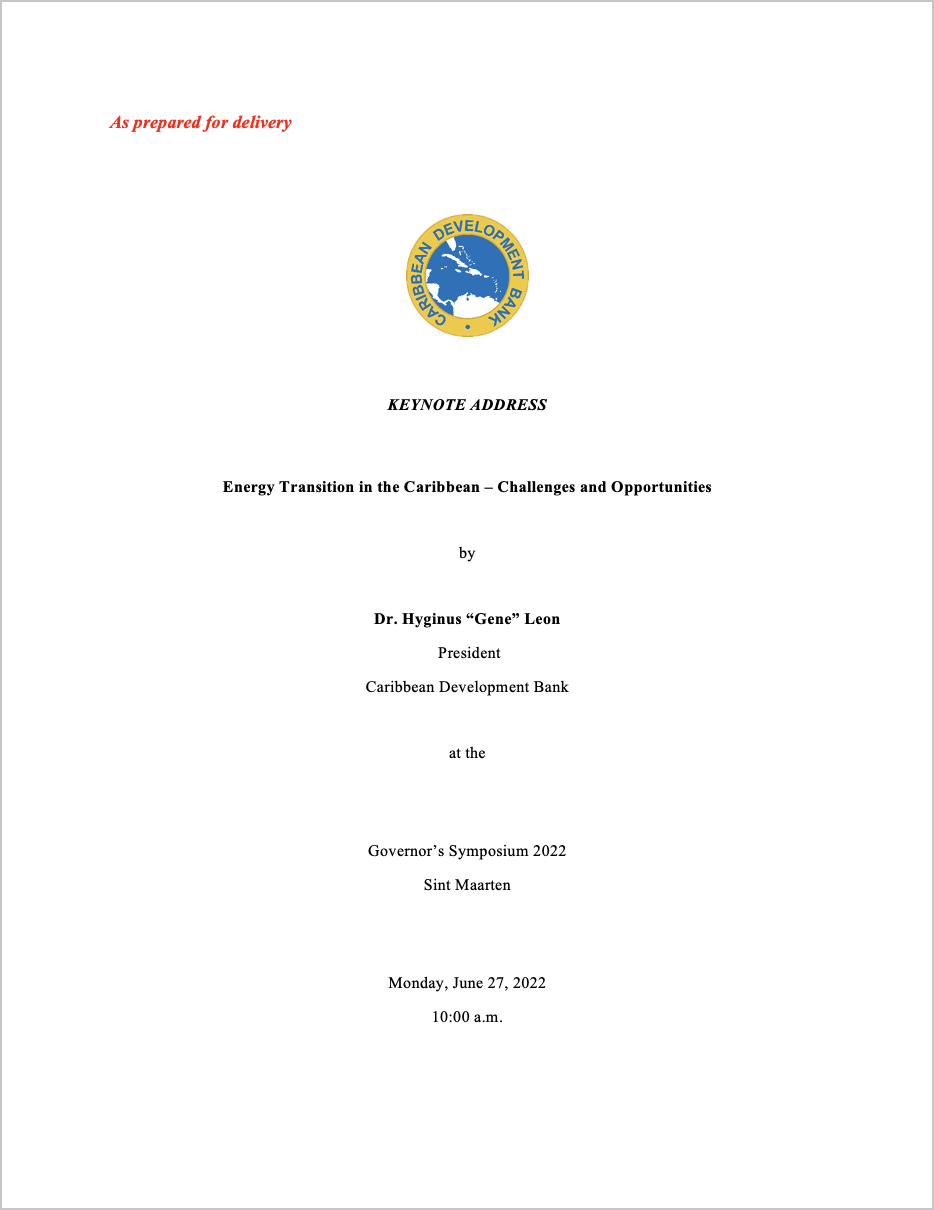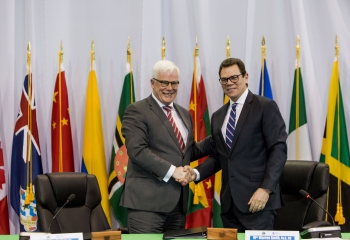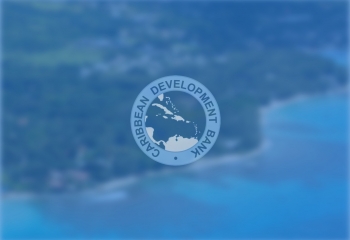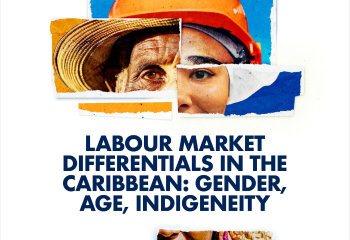Keynote- Energy Transition in the Caribbean – Challenges and Opportunities
I first wish to begin by expressing my sincerest thanks to the Governor for the invitation to deliver the keynote address at this event. In fact, I should also declare my appreciation for his patience – and for yours – as there was a clash in my calendar and I was presumptuous enough to inquire whether the date for the event could be changed! But I hasten to say that given my recent discussions with other countries in the Kingdom, I very much wanted to be here, and it is my hope that this is but a small step on the path to a long and productive relationship.
Today, in my small contribution to this very important exercise, I propose to: (1) reflect on the context of this event – that of sustainable development and its inescapable link to energy security; (2) share some observations on the imperative for energy transition in the Region; and (3) explore the current challenges and identify some key solutions that the Bank is pursuing and supporting.
Today’s symposium is timely. Why? It is occurring at a time when we are all focused on the importance of resilience. As I have stated, sustained development - development that meets the needs of the present without compromising the ability of future generations to meet their own needs - cannot be achieved without resilience, and because development has to be holistic, leaving no aspect behind, resilience must also be multi-faceted. Therefore, we need a resilience ecosystem capable of absorbing the exogenous shocks we are exposed to.
And so, although today’s discussion is essentially about energy resilience or energy security, let’s not forget that sustainable development is more than energy security, more than energy resilience. This symposium takes place against the backdrop of the enduring aftermath of COVID-19 and now the impact of the Russia-Ukraine war. This conflict has already affected commodity and financial markets, raised energy prices, increased inflation, heightened food insecurity, and slowed global growth. The sharp increase in energy prices is further straining fragile fiscal positions in Caribbean countries and threatening to derail any nascent economic recovery. This has undoubtedly brought even sharper into focus the case for the transition to renewable energy to accelerate energy security in the Region.
Energy, especially in the form of electricity, is the lifeblood of the modern economy and is therefore a sine qua non for economic and social development. The co-relation between economic growth and electricity use remains strong. Therefore, energy security or the uninterrupted availability of energy sources at an affordable price is critical. There are two indivisible aspects to energy security. The first is the long-term aspect, characterised by the need for timely investments to supply energy in line with economic developments and environmental needs. The second, short-term aspect is the ability of the energy system to react promptly to sudden changes in the supply-demand balance – that is, the ability to react to and recover from shocks, or stated differently, its resilience.
So, as we consider the challenges and opportunities for energy transition, we are really trying to establish a sustainable path to the “uninterrupted availability of energy sources at an affordable price” and in a manner which does not compromise energy for future generation. Importantly, in doing so, we also achieve energy security and ultimately resilience. Inherent in sustainability is the notion that the energy transition is about shifting from fossil-based energy to renewable energy (RE) options, which in the Caribbean are abundantly available, for example, in the form of solar, wind, and geothermal energy.
Imperative for energy transition in the Region
The achievement of the Sustainable Development Goals (SDGs) to which the international community, including Caribbean countries, has committed, requires sustainable energy (i.e., RE options and integrated energy efficiency approaches). At present however, the vast majority of the global and regional energy supply is derived from fossil fuel-based sources, which are, by definition, non-renewable and unsustainable.
Addressing the Climate Change crisis which is an existential issue for Small Island Developing States and low-lying Coastal States, requires that a radical and urgent shift be made away from fossil fuels to RE options as part of global de-carbonisation to achieve net-zero carbon emissions by 2050. This is so because the burning of fossil fuel for electricity production, for transportation, and industry is the main source of the majority of carbon dioxide emissions into the atmosphere, causing climate change. The Sixth Assessment Reports of the Inter-governmental Panel on Climate Change published in 2021 and 2022 have revealed that ‘global carbon emissions have continued to rise – albeit at a slowing rate – and it will be “impossible” to stay below 1.50C with “no or limited overshoot” without stronger climate action this decade’. In fact, a widely held view is that the likelihood of staying below 1.80C is of low probability, underpinning why adaptation is so important to our mitigation action efforts. To summarise the issue, future growth that is not green contributes to our very demise.
As part of the Paris Climate Change Agreement, all Caribbean countries have agreed to National Determined Contributions (NDCs) targets for reducing carbon emissions by 2030 as part of climate change mitigation efforts. Transitioning of their energy sector towards increased use of RE is the main strategy for achieving these NDCs, even as the current collective carbon emission contribution of Caribbean countries to the global stock is miniscule, being less than 1%.
Beyond contributing to the climate change threat, a reliance on fossil fuels generates a general lack of energy security. In our Region, the vast majority (84%) of the Borrowing Member Countries (BMCs) of the Caribbean Development Bank (CDB) rely on imported petroleum products (in the form diesel fuel and petrol) for electricity generation, transportation, industry, and cooking services. CDB’s borrowing member countries import more than 85% of their commercial energy supplies at value of USD8.2 billion in 2019 approximating to 8 % of their total Gross Domestic Product.
The dependence on this single undiversified energy source translates to significant risks for the economy, the environment, and society. The balance of payments impact from this over-dependence on imported oil arises from the persistent pressure on foreign reserves to fund imports as well as the management of reserves when faced with sudden price movements. The use of diesel technology for power generation, coupled with the lack of economies of scale associated with the small and isolated markets, have also resulted in the unit cost of electricity being among the highest in the world. The implications of this are far reaching: negatively impacting economic competitiveness. For example, it was observed that in 2019 the average electricity tariff in many Caribbean countries including St Maarten was in excess of USD30 cents per kilowatt-hour — which on average was more than 3 times that of the average in many developed country markets. Beyond competitiveness, this high price of electricity affects the poor and most vulnerable disproportionately and hence threatens poverty reduction efforts and the achievement of related SDGs.
Moreover, with energy cost a major part of governments’ budget, the impact of higher cost on fiscal space typically translates to less room to fund other development needs. Further, because oil prices have been historically volatile, the high reliance on imported fuels presents specific challenges to prudent fiscal management. The impact of volatility can be illustrated from the observation of an average increase of 50% in the price of oil for the first five months of 2022 when compared to average price in 2019. This has translated to a significantly increased cost of living, with implications for social protection of the most vulnerable.
To come closer to home, given that St Maarten derives virtually 100% its energy from imported petroleum products, it lacks energy security (like most Caribbean countries) and suffers from the risks associated with the vagaries of the international oil market. Let me be clear, if the energy insecure countries are to achieve their sustainable development goals, it is imperative that they move quickly to transform the energy sector to utilise our vast RE resources – I refer to solar, wind, and marine resources.
And as a caveat, let me note that the preceding arguments have focused on oil importers. Net oil exporters face different impacts from over dependence and face different transition challenges, not least being the pace of transition and the need to balance the effective use of natural resource endowments for the development of their economies with the responsibility of reducing the impact of their carbon footprints.
So where is the Region on the transition?
Despite governments taking initial initial steps including development of policies, establishing NDCs and Renewable Energy (RE)/Energy Efficiency (EE) targets, and making some investments in RE and EE, energy transition has been extremely slow. According to the World Bank, the average solar power potential in the Region lies at an impressive 1900 kWh per meter square year. This is more or less double the solar potential of Germany, for example, which has a mere 900 kWh per meter square year. For offshore wind, the World Bank estimates an even more impressive potential in the Caribbean of 751 GW, of which 238 GW could be generated by fixed and 513 GW by floating turbines (compared to a mere - 6 GW of total combined electrical peak demand for all CDB’s BMCs). Despite this potential only a handful of Caribbean countries, including Aruba, Dominica, the Dominican Republic, and Jamaica have a renewable energy share of more than 10 percent. Of course, while sharing a ride with panelist David Leonce yesterday, I learnt that the island of Saba was at 40% share – well on its way to a proposed target of 100% by 2025! Overall however, regional RE penetration for electricity generation in 2021 was a mere 12% and at the current rate we will not meet the target of 47% by 2027 or 55% by 2030.
The slow pace is due to a number of factors. Our geography and small population has left many of our countries with largely isolated grid networks with very modest generation capacity. Electricity systems tend to run at low efficiency and most the equipment is out of date. Meanwhile, our very dependence on fossil fuel imports has reduced our capacity to invest in renewable energy. Governance related barriers such as inadequate regulatory frameworks including tariffs, inefficient administration and maintenance as well as persisting monopolies in generation, transmission and distribution, further stymie progress.
As a result of the slow pace the Region is potentially missing out on significant opportunities and potential benefits to be had from a rapid transition. Beyond addressing our domestic energy sector challenges, the transition to renewable energy can allow some countries to leverage opportunities arising from the global de-carbonisation towards net-zero 2050. Specifically, the Region could develop new green energy sub-sectors and become net exporters of green energy. Two such opportunities are:
- Green-based export of goods and services: Given the European Union Carbon Border Adjustment Mechanism, which will implement a carbon tariff on carbon intensive products in 2026, could we target using that potential competitive advantage? This is a significant motivator for our energy exporters, who if they don’t reduce the carbon intensity of their exports will face being excluded from key markets such as the European Union. The real challenge is how to manage the pace of implementing disruptive technology since 30% or more of their economic activity depends on hydrocarbons. While the pace and extent of transition should be calibrated to circumstances of net-energy importers and net-energy exporters, strategically we could aim for an early mover advantage.
- Production of green energy carriers. All the net-zero-pathways developed by international organisations, such as the International Renewable Energy Agency, include significant roles for green energy carriers such as green hydrogen and green ammonia. Global demand for these products is expected to increase significantly by the end of this decade and present opportunities for our BMCs with large renewable energy resource endowments.
How do we accelerate the transition?
How then do we accelerate the energy transition to facilitate the sustainable development of Region and herald new and innovative sub-sectors? In our view, it all starts with an anchor goal as the vision (with minimal policy uncertainty) that is executed by integrating and aligning the process triangle of a well-articulated and disseminated warehouse of feasible and bankable projects (demand), adequate and affordable finance (supply), and an implementation infrastructure of strong governance and regulatory frameworks (environment) that together promote the necessary confidence for building a partnership for development between the private and public sectors.
We need therefore a framework for joint responsibility: a partnership with the private sector to engage on projects as development partners to achieve the anchors goals; financial institutions to devise innovative and flexible financing arrangements that can modify and reduce risk and thereby risk premia and required returns, making financing more affordable; governments to adopt appropriate regulatory governance and implementation frameworks to facilitate the crowding in of investments and leverage relevant technical and financial resources from strategic partnerships in the private sector, public sector, multilateral institutions, and international development agencies. We see that convening role as one CBD can champion!
The task at hand is no small feat. Achieving the regional target by 2030 will require an increase in our renewable energy penetration by approximately 43 percent which translates to increasing our capacity by around 2,600 megawatts within 8 years. On an annual basis, our renewable energy penetration rate will need to jump from the current 0.4 percent per year to around 5.4 percent. This would mean installing 320 megawatts renewable energy capacity per year, compared with the average of 25 megawatts per year installed over the last 9 years across the Region.
There is also the cost of the energy transition, which is larger than any single institution can implement on its own. Our own internal estimates suggest that shifting renewable energy capacity in the Region to just 320 megawatts per year from an average of approximately 25 megawatts per year will likely require an investment of approximately USD1.2 billion annually, a 16-fold increase above current levels.
We propose the Accelerated Sustainable Energy and Resilience Transformation 2030 Framework or ASERT-2030, which challenges countries and partners, including the private sector, to identify and pursue bold and urgent actions for a radical shift towards the use of sustainable energy. In this regard, the Bank has identified an initial suite of ASERT Initiatives (ASERTives) that we consider will enable the Region to achieve the targets. It goes without saying that a strong regulatory framework and an enabling environment will be essential for unlocking private sector participation. Indeed, we see scope for an objectives-focused complementarity between the public and private sectors. In other words, with a goal-oriented mission defined, how can the public and private sectors jointly contribute to that goal?
With your indulgence, I would like to highlight the potential of one of our ASERTives — Climate Resilient Sustainable Energy Roofs. This initiative could be pursued aggressively over the next decade and a half not only because of its immediate relevance to all BMCs in scaling up the transition, but also because it could facilitate inclusiveness through wide participation of citizenry. Our bold proposition is for the retrofitting and deployment of standards for new construction to build climate resilient sustainable roofs in 75 percent of homes in the Region by 2035. Imagine a process designed to manage the end-to-end value chains of design, fabrication, and installation all with regional resources. Imagine roof installations designed to withstand extreme weather events, while embedding solar, wind, water and other energy generation and storage technologies that are all networked through appropriately sized community electricity grids, with the potential to build social cohesion and social protection through the provision of community-based services?
Besides providing access to a multi-source energy base for households and communities literally through the redesign of our basic human need for shelter, this initiative can spur research and innovation in opportunities for greater diversification in generation (e.g., offshore wind), storage (e.g., battery storage technology), and distribution (e.g., integrated utilities) as well as enhanced energy security through the integration with other energy sources (e.g., geothermal, marine, and hydro). And if appropriately designed, would we not be able to even contemplate extreme weather conditions and environmental contamination as welcome nuisances?
Ladies and gentlemen, can I implore you to pause and consider how this one goal, if implemented as described, touches on all aspects of SDG7— universal access, increasing RE share, efficiency, security, research and technology, and infrastructure? And its potential through leveraging linkages to go even further on helping meet other SDGs, including social resilience and productive capacity?
We are making therefore a clarion call to all our strategic partners to work with us in the context of the proposed ASERT-2030 Framework for bold and urgent actions to transform the Region’s energy landscape and lay the ground for faster progress towards attaining the SDGs. If energy transition is to be sustainable and to yield the desired outcomes, our private sector must also play a central role. This would mean that these initiatives need to promote incentive compatibility and provide appropriate rates of social return that makes the transition worthwhile. What is probably most important for our private sector to deliberate on is the choice between the ability to make profits that can be short-lived and the ability to have environments that can sustain adequate rates of return over very long periods. Equally, shouldn’t we in the spirit of holistic development focus on measures of social rather than purely private return where social, environmental, institutional, and sustainability considerations are taken into account in measuring feasibility? Shouldn’t we focus on the feasibility of a continuum of linked projects as a chain rather than the piecemeal approach of feasibility of single projects?
I leave it to you to deliberate on what is most optimal for the future of our children. Indeed, the transition to renewable energy and to energy security is a debate on the kind of future we would like to bequeath to our children. It is one I think we have a moral obligation as parents to deliver on. It is one I think we cannot be shy or timid about. The will to create a bright sustainable future is clear. Let not therefore the optimism of our will be overcome by the pessimism of our intellect. Let us therefore engage boldly and in partnership to advance this imperative.
I thank you.






